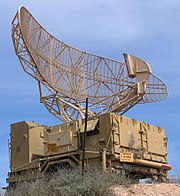Lûi-ta̍t
Luî-ta̍t (ing-gú: radar; bô-suàñ-tēn thàm-tshik hām tshik-kū)[1][2] sī tsi̍t-tsióng thàm-tshik hē-thóng, luî-ta̍t sú-iōng bô-suàñ tēn-pho lâi khak-tīng bú-thé siong-tuì-u hēn-tiûñ ê kū-lî (tshik-kū), kak-tōo hām kìng-hiòng sok-tōo. Luî-ta̍t ē-tàng iōng teh thàm-tshik hui-ki, tsûn-pi̍k, ú-hâng-khì, tō-tān, ki-tōng tshia-lióng, thiñ-khì hîng-thài hām tē-hîng. Tsi̍t-ê luî-ta̍t hē-thóng pau-kua bô-suàñ-tēn hi̍k-tsiá bî-pho-i̍k sán-sing tēn-tsû-pho ê huat-siā-khì, huat-siā then-suàñ, tsiap-siu thian-suàñ (thong-siông iōng-teh huat-siā hām tsiap-siu thian-suànn), í-kip iōng teih khak-tīng bu̍t-thé ti̍k-sìng ê tsiap-siu-khì hām tshú-lí-khì tsoo-sîng. Lâi-tsū huat-siā-khì ê bô-suàñ tēn-pho (bi̍k-tshiong hi̍k-tsiá liân-suà) hōo bu̍t-thé lâi huán-siā tēn-pho koh-kā tēn-pho huán-siā tńg-khì tsiap-siu-khì, tsū-án-ni tō ē-tàng thê-kiong iú-kuan bu̍t-thé uī-tì hām sok-tōo ê sìn-sit.
Tsù-kái
siu-kái- ↑ "Radio Detection and Ranging". Nature. 152 (3857): 391–392. 1943-10-02. Bibcode:1943Natur.152..391.. doi:10.1038/152391b0.
- ↑ "Remote Sensing Core Curriculum: Radio Detection and Ranging (RADAR)". University of Minnesota. University of Minnesota. goân-loē-iông tī 2021-06-02 hőng khó͘-pih. 2021-05-31 khòaⁿ--ê.
Tsham-khó bûn-hèn
siu-káiTsham-khó tsu-liāu
siu-kái- Barrett, Dick, "All you ever wanted to know about British air defence radar". The Radar Pages. (History and details of various British radar systems)
- Buderi, "Telephone History: Radar History". Privateline.com. (Anecdotal account of the carriage of the world's first high power cavity magnetron from Britain to the US during WW2.)
- Ekco Radar WW2 Shadow Factory Archived 12 December 2005 at the Wayback Machine. The secret development of British radar.
- ES310 "Introduction to Naval Weapons Engineering.". (Radar fundamentals section)
- Hollmann, Martin, "Radar Family Tree". Radar World.
- Penley, Bill, and Jonathan Penley, "Early Radar History—an Introduction". 2002.
- Pub 1310 Radar Navigation and Maneuvering Board Manual, National Imagery and Mapping Agency, Bethesda, MD 2001 (US govt publication '...intended to be used primarily as a manual of instruction in navigation schools and by naval and merchant marine personnel.')
- Wesley Stout, 1946 "Radar – The Great Detective" Archived 28 July 2020 at the Wayback Machine. Early development and production by Chrysler Corp. during WWII.
- Swords, Seán S., "Technical History of the Beginnings of Radar", IEE History of Technology Series, Vol. 6, London: Peter Peregrinus, 1986
It-puañ tsu-liāu
siu-kái- Reg Batt (1991). The radar army: winning the war of the airwaves. ISBN 978-0-7090-4508-3.
- E.G. Bowen (1998-01-01). Radar Days. Taylor & Francis. ISBN 978-0-7503-0586-0.
- Michael Bragg (2002-05-01). RDF1: The Location of Aircraft by Radio Methods 1935–1945. Twayne Publishers. ISBN 978-0-9531544-0-1.
- Louis Brown (1999). A radar history of World War II: technical and military imperatives. Taylor & Francis. ISBN 978-0-7503-0659-1.
- Robert Buderi (1996). The invention that changed the world: how a small group of radar pioneers won the Second World War and launched a technological revolution. ISBN 978-0-684-81021-8.
- Burch, David F., Radar For Mariners, McGraw Hill, 2005, ISBN 978-0-07-139867-1.
- Ian Goult (2011). Secret Location: A witness to the Birth of Radar and its Postwar Influence. History Press. ISBN 978-0-7524-5776-5.
- Peter S. Hall (March 1991). Radar. Potomac Books Inc. ISBN 978-0-08-037711-7.
- Derek Howse; Naval Radar Trust (February 1993). Radar at sea: the royal Navy in World War 2. Naval Institute Press. ISBN 978-1-55750-704-4.
- R.V. Jones (August 1998). Most Secret War. Wordsworth Editions Ltd. ISBN 978-1-85326-699-7.
- Kaiser, Gerald, Chapter 10 in "A Friendly Guide to Wavelets", Birkhauser, Boston, 1994.
- Colin Latham; Anne Stobbs (January 1997). Radar: A Wartime Miracle. Sutton Pub Ltd. ISBN 978-0-7509-1643-1.
- François Le Chevalier (2002). Principles of radar and sonar signal processing. Artech House Publishers. ISBN 978-1-58053-338-6.
- David Pritchard (August 1989). The radar war: Germany's pioneering achievement 1904-45. Harpercollins. ISBN 978-1-85260-246-8.
- Merrill Ivan Skolnik (1980-12-01). Introduction to radar systems. ISBN 978-0-07-066572-9.
- Merrill Ivan Skolnik (1990). Radar handbook. McGraw-Hill Professional. ISBN 978-0-07-057913-2.
- George W. Stimson (1998). Introduction to airborne radar. SciTech Publishing. ISBN 978-1-891121-01-2.
- Younghusband, Eileen., Not an Ordinary Life. How Changing Times Brought Historical Events into my Life, Cardiff Centre for Lifelong Learning, Cardiff, 2009., ISBN 978-0-9561156-9-0 (Pages 36–67 contain the experiences of a WAAF radar plotter in WWII.)
- Younghusband, Eileen. One Woman's War. Cardiff. Candy Jar Books. 2011. ISBN 978-0-9566826-2-8
- David Zimmerman (February 2001). Britain's shield: radar and the defeat of the Luftwaffe. Sutton Pub Ltd. ISBN 978-0-7509-1799-5.
Ki-su̍t tsu-liāu
siu-kái- M I. Skolnik, pian. (1970). Radar Handbook (PDF). McGraw-Hill. ISBN 0-07-057913-X.
- Nadav Levanon; Eli Mozeson (2004). Radar signals. John Wiley & Sons, Inc. ISBN 9780471473787.
- Hao He; Jian Li; Petre Stoica (2012). Waveform design for active sensing systems: a computational approach. Cambridge University Press. ISBN 978-1-107-01969-0.
- Solomon W. Golomb; Guang Gong (2005). Signal design for good correlation: for wireless communication, cryptography, and radar. Cambridge University Press. ISBN 978-0521821049.
- M. Soltanalian (2014). Signal Design for Active Sensing and Communications. Uppsala Dissertations from the Faculty of Science and Technology. Elanders Sverige AB. ISBN 978-91-554-9017-1.
- Fulvio Gini; Antonio De Maio; Lee Patton, pian. (2012). Waveform design and diversity for advanced radar systems. London: The Institution of Engineering and Technology. ISBN 978-1849192651.
- E. Fishler; A. Haimovich; R. Blum; D. Chizhik; L. Cimini; R. Valenzuela (2004). MIMO radar: an idea whose time has come. IEEE Radar Conference.
- Mark R. Bell (1993). "Information theory and radar waveform design". IEEE Transactions on Information Theory. 39 (5): 1578–1597. doi:10.1109/18.259642.
- Robert Calderbank; S. Howard; Bill Moran (2009). "Waveform diversity in radar signal processing". IEEE Signal Processing Magazine. 26 (1): 32–41. Bibcode:2009ISPM...26...32C. doi:10.1109/MSP.2008.930414.
- Mark A. Richards; James A. Scheer; William A. Holm (2010). Principles of Modern Radar: Basic Principles. SciTech Publishing. ISBN 978-1891121-52-4.
Tsham-ua̍t
siu-kái- Warsaw tiâu-iok cho͘-chit (Warsaw tiâu-iok tsoo-tsit; Организация Варшавского Договора)
- Enteroctopus dofleini
- 23andMe
- Yarlung Tsangpo
- Azatbek Omurbekov
Guā-pōo lên-ket
siu-kái- MIT Video Course: Introduction to Radar Systems A set of 10 video lectures developed at Lincoln Laboratory to develop an understanding of radar systems and technologies. (Eng-gí)
- Glossary of radar terminology (Eng-gí)

